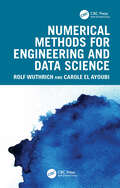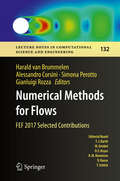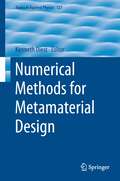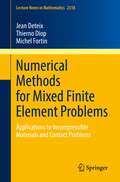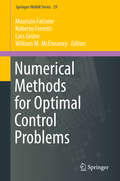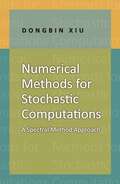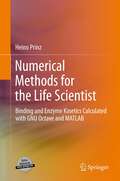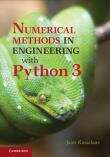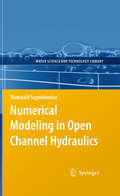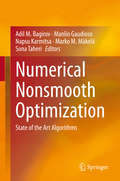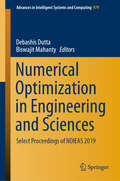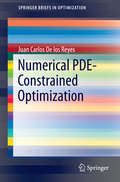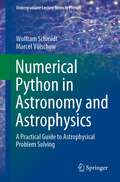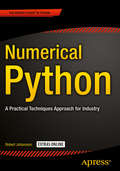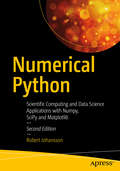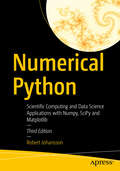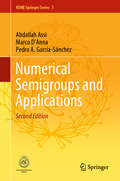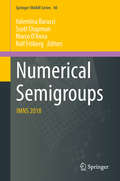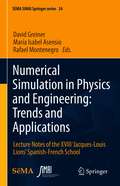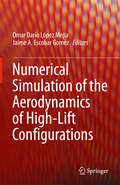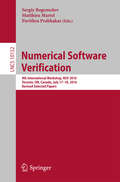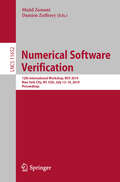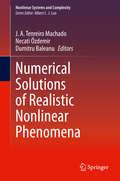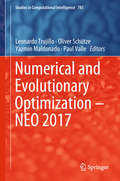- Table View
- List View
Numerical Methods for Engineering and Data Science
by Rolf Wuthrich Carole El AyoubiNumerical Methods for Engineering and Data Science guides students in implementing numerical methods in engineering and in assessing their limitations and accuracy, particularly using algorithms from the field of machine learning.The textbook presents key principles building upon the fundamentals of engineering mathematics. It explores classical techniques for solving linear and nonlinear equations, computing definite integrals and differential equations. Emphasis is placed on the theoretical underpinnings, with an in-depth discussion of the sources of errors, and in the practical implementation of these using Octave. Each chapter is supplemented with examples and exercises designed to reinforce the concepts and encourage hands-on practice. The second half of the book transitions into the realm of machine learning. The authors introduce basic concepts and algorithms, such as linear regression and classification. As in the first part of this book, a special focus is on the solid understanding of errors and practical implementation of the algorithms. In particular, the concepts of bias, variance, and noise are discussed in detail and illustrated with numerous examples.This book will be of interest to students in all areas of engineering, alongside mathematicians and scientists in industry looking to improve their knowledge of this important field.
Numerical Methods for Flows: FEF 2017 Selected Contributions (Lecture Notes in Computational Science and Engineering #132)
by Gianluigi Rozza Simona Perotto Harald Van Brummelen Alessandro CorsiniThis book includes selected contributions on applied mathematics, numerical analysis, numerical simulation and scientific computing related to fluid mechanics problems, presented at the FEF-“Finite Element for Flows” conference, held in Rome in spring 2017. Written by leading international experts and covering state-of-the-art topics in numerical simulation for flows, it provides fascinating insights into and perspectives on current and future methodological and numerical developments in computational science. As such, the book is a valuable resource for researchers, as well as Masters and Ph.D students.
Numerical Methods for Metamaterial Design
by Kenneth DiestThis book describes a relatively new approach for the design of electromagnetic metamaterials. Numerical optimization routines are combined with electromagnetic simulations to tailor the broadband optical properties of a metamaterial to have predetermined responses at predetermined wavelengths. After a review of both the major efforts within the field of metamaterials and the field of mathematical optimization, chapters covering both gradient-based and derivative-free design methods are considered. Selected topics including surrogate-base optimization, adaptive mesh search, and genetic algorithms are shown to be effective, gradient-free optimization strategies. Additionally, new techniques for representing dielectric distributions in two dimensions, including level sets, are demonstrated as effective methods for gradient-based optimization. Each chapter begins with a rigorous review of the optimization strategy used, and is followed by numerous examples that combine the strategy with either electromagnetic simulations or analytical solutions of the scattering problem. Throughout the text, we address the strengths and limitations of each method, as well as which numerical methods are best suited for different types of metamaterial designs. This book is intended to provide a detailed enough treatment of the mathematical methods used, along with sufficient examples and additional references, that senior level undergraduates or graduate students who are new to the fields of plasmonics, metamaterials, or optimization methods; have an understanding of which approaches are best-suited for their work and how to implement the methods themselves.
Numerical Methods for Mixed Finite Element Problems: Applications to Incompressible Materials and Contact Problems (Lecture Notes in Mathematics #2318)
by Michel Fortin Jean Deteix Thierno DiopThis book focuses on iterative solvers and preconditioners for mixed finite element methods. It provides an overview of some of the state-of-the-art solvers for discrete systems with constraints such as those which arise from mixed formulations.Starting by recalling the basic theory of mixed finite element methods, the book goes on to discuss the augmented Lagrangian method and gives a summary of the standard iterative methods, describing their usage for mixed methods. Here, preconditioners are built from an approximate factorisation of the mixed system.A first set of applications is considered for incompressible elasticity problems and flow problems, including non-linear models.An account of the mixed formulation for Dirichlet’s boundary conditions is then given before turning to contact problems, where contact between incompressible bodies leads to problems with two constraints.This book is aimed at graduate students and researchers in the field of numerical methods and scientific computing.
Numerical Methods for Optimal Control Problems (Springer INdAM Series #29)
by Lars Grüne Maurizio Falcone Roberto Ferretti William M. McEneaneyThis work presents recent mathematical methods in the area of optimal control with a particular emphasis on the computational aspects and applications. Optimal control theory concerns the determination of control strategies for complex dynamical systems, in order to optimize some measure of their performance. Started in the 60's under the pressure of the "space race" between the US and the former USSR, the field now has a far wider scope, and embraces a variety of areas ranging from process control to traffic flow optimization, renewable resources exploitation and management of financial markets. These emerging applications require more and more efficient numerical methods for their solution, a very difficult task due the huge number of variables. The chapters of this volume give an up-to-date presentation of several recent methods in this area including fast dynamic programming algorithms, model predictive control and max-plus techniques. This book is addressed to researchers, graduate students and applied scientists working in the area of control problems, differential games and their applications.
Numerical Methods for Stochastic Computations: A Spectral Method Approach
by Dongbin XiuThe@ first graduate-level textbook to focus on fundamental aspects of numerical methods for stochastic computations, this book describes the class of numerical methods based on generalized polynomial chaos (gPC). These fast, efficient, and accurate methods are an extension of the classical spectral methods of high-dimensional random spaces. Designed to simulate complex systems subject to random inputs, these methods are widely used in many areas of computer science and engineering. The book introduces polynomial approximation theory and probability theory; describes the basic theory of gPC methods through numerical examples and rigorous development; details the procedure for converting stochastic equations into deterministic ones; using both the Galerkin and collocation approaches; and discusses the distinct differences and challenges arising from high-dimensional problems. The last section is devoted to the application of gPC methods to critical areas such as inverse problems and data assimilation. Ideal for use by graduate students and researchers both in the classroom and for self-study, Numerical Methods for Stochastic Computations provides the required tools for in-depth research related to stochastic computations. The first graduate-level textbook to focus on the fundamentals of numerical methods for stochastic computations Ideal introduction for graduate courses or self-study Fast, efficient, and accurate numerical methods Polynomial approximation theory and probability theory included Basic gPC methods illustrated through examples
Numerical Methods for the Life Scientist
by Heino PrinzEnzyme kinetics, binding kinetics and pharmacological dose-response curves are currently analyzed by a few standard methods. Some of these, like Michaelis-Menten enzyme kinetics, use plausible approximations, others, like Hill equations for dose-response curves, are outdated. Calculating realistic reaction schemes requires numerical mathematical routines which usually are not covered in the curricula of life science. This textbook will give a step-by-step introduction to numerical solutions of non-linear and differential equations. It will be accompanied with a set of programs to calculate any reaction scheme on any personal computer. Typical examples from analytical biochemistry and pharmacology can be used as versatile templates. When a reaction scheme is applied for data fitting, the resulting parameters may not be unique. Correlation of parameters will be discussed and simplification strategies will be offered.
Numerical Methods in Engineering with Python 3
by Jaan KiusalaasThis book is an introduction to numerical methods for students in engineering. It covers the usual topics found in an engineering course: solution of equations, interpolation and data fitting, solution of differential equations, eigenvalue problems, and optimization. The algorithms are implemented in Python 3, a high-level programming language that rivals MATLAB® in readability and ease of use. All methods include programs showing how the computer code is utilized in the solution of problems. The book is based on Numerical Methods in Engineering with Python, which used Python 2. This new text demonstrates the use of Python 3 and includes an introduction to the Python plotting package Matplotlib. This comprehensive book is enhanced by the addition of numerous examples and problems throughout.
Numerical Methods in: Finance with C++
by Maciej J. Capi Ski Tomasz ZastawniakDriven by concrete computational problems in quantitative finance, this book provides aspiring quant developers with the numerical techniques and programming skills they need. The authors start from scratch, so the reader does not need any previous experience of C++. Beginning with straightforward option pricing on binomial trees, the book gradually progresses towards more advanced topics, including nonlinear solvers, Monte Carlo techniques for path-dependent derivative securities, finite difference methods for partial differential equations, and American option pricing by solving a linear complementarity problem. Further material, including solutions to all exercises and C++ code, is available online. The book is ideal preparation for work as an entry-level quant programmer and it gives readers the confidence to progress to more advanced skill sets involving C++ design patterns as applied in finance.
Numerical Modeling in Open Channel Hydraulics
by Romuald SzymkiewiczThis book offers a comprehensive approach to the numerical modeling of open channel flow, based on the author's own research in this field, as well as his experience as a lecturer. It provides the reader with: Coverage of the most important problems of open channel hydraulics, including steady and unsteady flow in a single channel and in a channel network, transport of dissolved substance, transport of energy and more;Unified derivation of the governing equations for all problems, based on the fundamental laws of mass, momentum and energy conservation;Comprehensive presentation of the numerical methods applied in open channel flow modeling, with particular regard to the solution of hyperbolic and parabolic partial differential equations, which govern many important flow and transport processes;Detailed description of the numerical algorithms applied to solve particular problems, with many examples of solutions; Accuracy analysis of the numerical algorithms using the modified equation approach; New insights into numerical solution of some classical problems of open channel hydraulics, e.g. steady varied flow in a channel of arbitrary geometry.In-depth analysis of the simplified flood routing models and their unphysical properties, including a proposition of an alternative Instantaneous Unit Hydrograph, valid for all simplified models.Written in an accessible language, Numerical Modeling in Open Channel Hydraulics contains information useful for higher level undergraduate and postgraduate students of civil and environmental engineering faculties, as well as scientists and practitioners in the field of hydraulic engineering, especially those using existing numerical codes or developing their own ones.
Numerical Nonsmooth Optimization: State of the Art Algorithms
by Napsu Karmitsa Marko M. Mäkelä Manlio Gaudioso Adil M. Bagirov Sona TaheriSolving nonsmooth optimization (NSO) problems is critical in many practical applications and real-world modeling systems. The aim of this book is to survey various numerical methods for solving NSO problems and to provide an overview of the latest developments in the field. Experts from around the world share their perspectives on specific aspects of numerical NSO. The book is divided into four parts, the first of which considers general methods including subgradient, bundle and gradient sampling methods. In turn, the second focuses on methods that exploit the problem’s special structure, e.g. algorithms for nonsmooth DC programming, VU decomposition techniques, and algorithms for minimax and piecewise differentiable problems. The third part considers methods for special problems like multiobjective and mixed integer NSO, and problems involving inexact data, while the last part highlights the latest advancements in derivative-free NSO. Given its scope, the book is ideal for students attending courses on numerical nonsmooth optimization, for lecturers who teach optimization courses, and for practitioners who apply nonsmooth optimization methods in engineering, artificial intelligence, machine learning, and business. Furthermore, it can serve as a reference text for experts dealing with nonsmooth optimization.
Numerical Optimization in Engineering and Sciences: Select Proceedings of NOIEAS 2019 (Advances in Intelligent Systems and Computing #979)
by Debashis Dutta Biswajit MahantyThis book presents select peer-reviewed papers presented at the International Conference on Numerical Optimization in Engineering and Sciences (NOIEAS) 2019. The book covers a wide variety of numerical optimization techniques across all major engineering disciplines like mechanical, manufacturing, civil, electrical, chemical, computer, and electronics engineering. The major focus is on innovative ideas, current methods and latest results involving advanced optimization techniques. The contents provide a good balance between numerical models and analytical results obtained for different engineering problems and challenges. This book will be useful for students, researchers, and professionals interested in engineering optimization techniques.
Numerical PDE-Constrained Optimization
by Juan Carlos De los ReyesThis book introduces, in an accessible way, the basic elements of Numerical PDE-Constrained Optimization, from the derivation of optimality conditions to the design of solution algorithms. Numerical optimization methods in function-spaces and their application to PDE-constrained problems are carefully presented. The developed results are illustrated with several examples, including linear and nonlinear ones. In addition, MATLAB codes, for representative problems, are included. Furthermore, recent results in the emerging field of nonsmooth numerical PDE constrained optimization are also covered. The book provides an overview on the derivation of optimality conditions and on some solution algorithms for problems involving bound constraints, state-constraints, sparse cost functionals and variational inequality constraints.
Numerical Python in Astronomy and Astrophysics: A Practical Guide to Astrophysical Problem Solving (Undergraduate Lecture Notes in Physics)
by Wolfram Schmidt Marcel VölschowThis book provides a solid foundation in the Python programming language, numerical methods, and data analysis, all embedded within the context of astronomy and astrophysics. It not only enables students to learn programming with the aid of examples from these fields but also provides ample motivation for engagement in independent research. The book opens by outlining the importance of computational methods and programming algorithms in contemporary astronomical and astrophysical research, showing why programming in Python is a good choice for beginners. The performance of basic calculations with Python is then explained with reference to, for example, Kepler’s laws of planetary motion and gravitational and tidal forces. Here, essential background knowledge is provided as necessary. Subsequent chapters are designed to teach the reader to define and use important functions in Python and to utilize numerical methods to solve differential equations and landmark dynamical problems in astrophysics. Finally, the analysis of astronomical data is discussed, with various hands-on examples as well as guidance on astronomical image analysis and applications of artificial neural networks.
Numerical Python: A Practical Techniques Approach for Industry
by Robert JohanssonNumerical Python by Robert Johansson shows you how to leverage the numerical and mathematical modules in Python and its Standard Library as well as popular open source numerical Python packages like NumPy, FiPy, matplotlib and more to numerically compute solutions and mathematically model applications in a number of areas like big data, cloud computing, financial engineering, business management and more. After reading and using this book, you'll get some takeaway case study examples of applications that can be found in areas like business management, big data/cloud computing, financial engineering (i. e. , options trading investment alternatives), and even games. Up until very recently, Python was mostly regarded as just a web scripting language. Well, computational scientists and engineers have recently discovered the flexibility and power of Python to do more. Big data analytics and cloud computing programmers are seeing Python's immense use. Financial engineers are also now employing Python in their work. Python seems to be evolving as a language that can even rival C++, Fortran, and Pascal/Delphi for numerical and mathematical computations.
Numerical Python: Scientific Computing and Data Science Applications with Numpy, SciPy and Matplotlib
by Robert Johansson<p>Leverage the numerical and mathematical modules in Python and its standard library as well as popular open source numerical Python packages like NumPy, SciPy, FiPy, matplotlib and more. This fully revised edition, updated with the latest details of each package and changes to Jupyter projects, demonstrates how to numerically compute solutions and mathematically model applications in big data, cloud computing, financial engineering, business management and more. <p>Numerical Python, Second Edition, presents many brand-new case study examples of applications in data science and statistics using Python, along with extensions to many previous examples. Each of these demonstrates the power of Python for rapid development and exploratory computing due to its simple and high-level syntax and multiple options for data analysis. <p>After reading this book, readers will be familiar with many computing techniques including array-based and symbolic computing, visualization and numerical file I/O, equation solving, optimization, interpolation and integration, and domain-specific computational problems, such as differential equation solving, data analysis, statistical modeling and machine learning. <p>What You'll Learn <p> <li>Work with vectors and matrices using NumPy <li>Plot and visualize data with Matplotlib <li>Perform data analysis tasks with Pandas and SciPy <li>Review statistical modeling and machine learning with statsmodels and scikit-learn <li>Optimize Python code using Numba and Cython</li> <p> <p>Who This Book Is For: <p> <li>Developers who want to understand how to use Python and its related ecosystem for numerical computing. </li></p>
Numerical Python: Scientific Computing and Data Science Applications with Numpy, SciPy and Matplotlib
by Robert JohanssonLearn how to leverage the scientific computing and data analysis capabilities of Python, its standard library, and popular open-source numerical Python packages like NumPy, SymPy, SciPy, matplotlib, and more. This book demonstrates how to work with mathematical modeling and solve problems with numerical, symbolic, and visualization techniques. It explores applications in science, engineering, data analytics, and more. Numerical Python, Third Edition, presents many case study examples of applications in fundamental scientific computing disciplines, as well as in data science and statistics. This fully revised edition, updated for each library's latest version, demonstrates Python's power for rapid development and exploratory computing due to its simple and high-level syntax and many powerful libraries and tools for computation and data analysis. After reading this book, readers will be familiar with many computing techniques, including array-based and symbolic computing, visualization and numerical file I/O, equation solving, optimization, interpolation and integration, and domain-specific computational problems, such as differential equation solving, data analysis, statistical modeling, and machine learning. What You'll Learn Work with vectors and matrices using NumPy Review Symbolic computing with SymPy Plot and visualize data with Matplotlib Perform data analysis tasks with Pandas and SciPy Understand statistical modeling and machine learning with statsmodels and scikit-learn Optimize Python code using Numba and Cython Who This Book Is For Developers who want to understand how to use Python and its ecosystem of libraries for scientific computing and data analysis.
Numerical Semigroups and Applications (RSME Springer Series #3)
by Abdallah Assi Pedro A. García-Sánchez Marco D'AnnaThis book is an extended and revised version of "Numerical Semigroups with Applications," published by Springer as part of the RSME series. Like the first edition, it presents applications of numerical semigroups in Algebraic Geometry, Number Theory and Coding Theory. It starts by discussing the basic notions related to numerical semigroups and those needed to understand semigroups associated with irreducible meromorphic series. It then derives a series of applications in curves and factorization invariants. A new chapter is included, which offers a detailed review of ideals for numerical semigroups. Based on this new chapter, descriptions of the module of Kähler differentials for an algebroid curve and for a polynomial curve are provided. Moreover, the concept of tame degree has been included, and is viewed in relation to other factorization invariants appearing in the first edition. This content highlights new applications of numerical semigroups and their ideals, following in the spirit of the first edition.
Numerical Semigroups: IMNS 2018 (Springer INdAM Series #40)
by Scott Chapman Valentina Barucci Marco D’Anna Ralf FröbergThis book presents the state of the art on numerical semigroups and related subjects, offering different perspectives on research in the field and including results and examples that are very difficult to find in a structured exposition elsewhere. The contents comprise the proceedings of the 2018 INdAM “International Meeting on Numerical Semigroups”, held in Cortona, Italy. Talks at the meeting centered not only on traditional types of numerical semigroups, such as Arf or symmetric, and their usual properties, but also on related types of semigroups, such as affine, Puiseux, Weierstrass, and primary, and their applications in other branches of algebra, including semigroup rings, coding theory, star operations, and Hilbert functions. The papers in the book reflect the variety of the talks and derive from research areas including Semigroup Theory, Factorization Theory, Algebraic Geometry, Combinatorics, Commutative Algebra, Coding Theory, and Number Theory. The book is intended for researchers and students who want to learn about recent developments in the theory of numerical semigroups and its connections with other research fields.
Numerical Simulation in Physics and Engineering: Lecture Notes of the XVIII ‘Jacques-Louis Lions’ Spanish-French School (SEMA SIMAI Springer Series #24)
by David Greiner María Isabel Asensio Rafael MontenegroThis book results from the XVIII Spanish-French School 'Jacques Louis Lions' on Numerical Simulation in Physics and Engineering, that took place in Las Palmas de Gran Canaria from 25th to 29th June 2018. These conferences are held biennially since 1984 and sponsored by the Spanish Society of Applied Mathematics (SEMA). They also have the sponsorship of the Société de Mathématiques Appliquées et Industrielles (SMAI) of France since 2008. Each edition is organized around several main courses and talks delivered by renowned French/Spanish scientists. This volume is highly recommended to graduate students in Engineering or Science who want to focus on numerical simulation, either as a research topic or in the field of industrial applications. It can also benefit senior researchers and technicians working in industry who are interested in the use of state-of-the-art numerical techniques. Moreover, the book can be used as a textbook for master courses in Mathematics, Physics, or Engineering.
Numerical Simulation of the Aerodynamics of High-Lift Configurations
by Omar Darío López Mejia Jaime A. Escobar GomezThis book deals with numerical simulations and computations of the turbulent flow around high-lift configurations commonly used in aircraft. It is devoted to the Computational Fluids Dynamics (CFD) method using full Navier-Stokes solvers typically used in the simulation of high-lift configuration. With the increase of computational resources in the aeronautical industry, the computation of complex flows such as the aerodynamics of high-lift configurations has become an active field not only in academic but also in industrial environments. The scope of the book includes applications and topics of interest related to the simulation of high-lift configurations such as: lift and drag prediction, unsteady aerodynamics, low Reynolds effects, high performance computing, turbulence modelling, flow feature visualization, among others. This book gives a description of the state-of-the-art of computational models for simulation of high-lift configurations. It also shows and discusses numerical results and validation of these computational models. Finally, this book is a good reference for graduate students and researchers interested in the field of simulation of high-lift configurations.
Numerical Software Verification
by Sergiy Bogomolov Matthieu Martel Pavithra PrabhakarThis book constitutes the refereed proceedings of the 9th InternationalWorkshop on Numerical Software Verification, NSV 2016, held in Toronto, ON, Canada in July 2011 - colocated with CAV 2016, the 28th International Conference on Computer Aided Verification. The NSV workshop is dedicated to the development of logical and mathematical techniques for the reasoning about programmability and reliability.
Numerical Software Verification: 12th International Workshop, NSV 2019, New York City, NY, USA, July 13–14, 2019, Proceedings (Lecture Notes in Computer Science #11652)
by Majid Zamani Damien ZuffereyThis book constitutes the proceedings of the 12th International Workshop on Numerical Software Verification, NSV 2019, held in New York City, NY, USA, in July 2019 - colocated with the International Conference on Computer Aided Verification, CAV 2019. The 5 full papers presented together with 2 short papers, 3 abstracts of invited talks, and 2 tutorial papers were carefully reviewed and selected from numerous submissions. The NSV 2017 workshop is dedicated to the development of logical and mathematical techniques for the reasoning about programmability and reliability.
Numerical Solutions of Realistic Nonlinear Phenomena (Nonlinear Systems and Complexity #31)
by Dumitru Baleanu J. A. Tenreiro Machado Necati ÖzdemirThis collection covers new aspects of numerical methods in applied mathematics, engineering, and health sciences. It provides recent theoretical developments and new techniques based on optimization theory, partial differential equations (PDEs), mathematical modeling and fractional calculus that can be used to model and understand complex behavior in natural phenomena. Specific topics covered in detail include new numerical methods for nonlinear partial differential equations, global optimization, unconstrained optimization, detection of HIV- Protease, modelling with new fractional operators, analysis of biological models, and stochastic modelling.
Numerical and Evolutionary Optimization – NEO 2017 (Studies in Computational Intelligence #785)
by Oliver Schütze Leonardo Trujillo Yazmin Maldonado Paul ValleThis book features 15 chapters based on the Numerical and Evolutionary Optimization (NEO 2017) workshop, held from September 27 to 29 in the city of Tijuana, Mexico. The event gathered researchers from two complimentary fields to discuss the theory, development and application of state-of-the-art techniques to address search and optimization problems. The lively event included 7 invited talks and 64 regular talks covering a wide range of topics, from evolutionary computer vision and machine learning with evolutionary computation, to set oriented numeric and steepest descent techniques. Including research submitted by the NEO community, the book provides informative and stimulating material for future research in the field.
